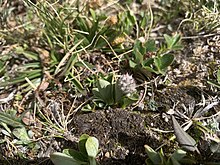User:AndreaNwilliams/Uncompahgre fritillary
Uncompahgre fritillary butterfly
[edit]![]() There is already an article named Uncompahgre fritillary in the mainspace.
There is already an article named Uncompahgre fritillary in the mainspace.
| AndreaNwilliams/Uncompahgre fritillary | |
|---|---|

| |
Invalid status (ESA)
| |
| Scientific classification | |
| Kingdom: | |
| Phylum: | |
| Class: | |
| Order: | |
| Family: | |
| Genus: | |
| Species: | C. i. acrocnema
|
| Binomial name | |
| Clossiana improba acrocnema U.S. Fish and Wildlife, 2018
| |
The Uncompahgre fritillary butterfly (Clossiana improba acrocnema) is a species of butterfly in the Order Lepidoptera, Family Nymphalidae that is endemic to Colorado, USA.[1]
Description
[edit]Discovered in the summer of 1978, the Uncompahgre fritillary was first described as a subspecies of Boloria improba, commonly known as the dingy fritillary[2] but further genetic data supported classifying them as a species.[3] The closest known relative of the Uncompahgre fritillary is Clossiana harryi, found within the Wind River Mountain Range in Wyoming. The adult butterflies are small with a fuzzy, dark brown to black body and brown-black antennae. Their wingspan is approximately 1 inch wide and they can be tan, orange, brown and black in color with a distinct triangular shape emerging on the dorsal and ventral wing. The males and females are differentiated by the females wings being slightly lighter in color than the males.[4][5]

Distribution
[edit]The Uncompahgre fritillary was first found above tree-line at Uncompahgre Peak, located in Hinsdale County, Colorado, USA by Larry Gall, Felix Sperling, Scott Graham, Kathleen Shaw, and Wendy Roberts working out of the Rocky Mountain Biological Laboratory.[6] A few years following, another population was found at Redcloud Peak, about 10 miles south of Uncompahgre Peak.[6]
It is endemic to the San Juan Mountains of southwestern Colorado, USA and has one of the smallest known ranges of all North American butterflies.[4]
The habitat of the Uncompahgre fritillary includes high elevations (3800-4100m above sea level), northeast facing montane meadows with varying slopes.
Host plant
[edit]The Uncompahgre fritillary is a specialist species regarding their selected larval food source and egg-laying substrate. They can be found in

habitats that have patches of their host plant which is snow willow (Salix nivalis).[7]
Life Cycle
[edit]Female butterflies lay their eggs individually on snow willow stems and leaves around the middle of July and don't hatch until numerous weeks later.[8] The eggs are tan in color and take multiple weeks to hatch which the larvae then feed on snow willow leaves throughout their biennial life cycle and overwinter under the snow until they emerge the following spring and molt.[8]
Management
[edit]Population decline
[edit]Mark-recapture methods completed within a decade of their discovery showed consistently low population estimates at Uncompahgre Peak and Redcloud Peak. It was thought to be on the edge of extinction and was added to the Endangered Species List in 1991. Since then, early monitoring programs have found a number of additional populations in the San Juan Mountains but the small numbers detected at each of these locations remain inadequate for delisting.[4] An additional threat is the possibility of low genetic variability between the populations.[1]
Recovery efforts
[edit]The Uncompahgre fritillary butterfly is still considered Federally Endangered by the U.S. Fish and Wildlife Service and the recovery plan prioritizes actions to better understand the reasons for their continuous decline and prevention from significant population declines and extinction.[4] Predicted threats to this species include: climate change, grazing, illegal collection, and recreation. Efforts have taken place to install signage at the trailheads of popular hiking trails, Redcloud Peak and Uncompahgre Peak. The trails have also been diverted to around the populations, whereas they were crossing directly through the butterfly colonies before.
- ^ a b U.S. Fish and Wildlife Service (2018). Uncompahgre Fritillary Butterfly (Clossiana improba acrocnema) 5-Year Review: Summary and Evaluation. Western Slope Office, Colorado Ecological Services, Grand Junction, Colorado.
- ^ Scott, J.A. 1986. The butterflies of North America - A natural history and field guide. Stanford University Press, Stanford, CA, USA. 583 pp.
- ^ Gall, L.F., and F.A.H. Sperling. 1980. A new high altitude species of Boloria from southwestern Colorado (Nymphalidae), with a discussion of phonetics and hierarchical decisions. J. Lepidopterists's Soc. 34:230-252.
- ^ a b c d Fish and Wildlife Service. 1994. Uncompahgre Fritillary Butterfly Recovery Plan. Denver, Colorado. 20 pp.
- ^ Gall, L.F. 1983. Uncompahgre fritillary butterfly. Pages 477—479 in The IUCN Invertebrate Red Data Book. S.M. Wells, R.M. Pyle, N.M. Collins, eds. International Union for Conservation of Nature and Natural Resources, Gland, Switzerland. 632 pp.
- ^ a b Pfeiler, Edward (1980). "Boloria bellona(Fabricius) (Nymphalidae: Heliconiinae) from the Blue Mountains of the Pacific Northwest". Journal of the Lepidopterists’ Society. 67 (2): 143–144. doi:10.18473/lepi.v67i2.a6. ISSN 0024-0966 – via ResearchGate.
- ^ Britten, Hugh B.; Brussard, Peter F.; Murphy, Dennis D. (1994-03). "The Pending Extinction of the Uncompahgre Fritillary Butterfly". Conservation Biology. 8 (1): 86–94. doi:10.1046/j.1523-1739.1994.08010086.x. ISSN 0888-8892.
{{cite journal}}: Check date values in:|date=(help) - ^ a b Scott, James A. (1984) The Life History and Ecology of an alpine relict, Boloria improba acrocnema (Lepidoptera: Nymphalidae), illustrating a new mathematical population census method. Papilio (2).
